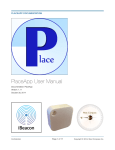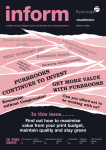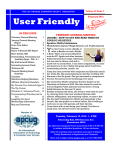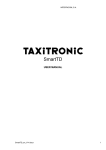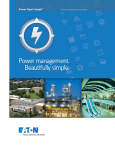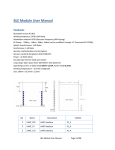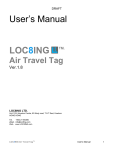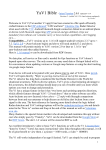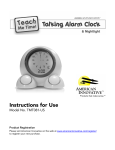Download Beacons: Get to The Point
Transcript
Beacons: Get to The Point You may be hearing the buzz about beacons in the retail world – iBeacons, PayPal Beacons, and so on. While the excitement around beacons is clear, it can be difficult to understand what beacons really are, what they can do for you, and why you should care. In this first installment of Trepoint’s whitepaper series “Get to The Point,” we’ll explore those questions. The Point: Beacons have the potential to deliver the ultimate digital in-store shopping experience that will benefit consumers, manufactures and retailers alike. If you want to create a competitive marketing advantage, get started with your beacon experimentation now, or play catch-up after your competitors have cracked the code. 1 How Challenger Brands Move into Action What’s a beacon? In short, a beacon is a small physical device that talks through short-range beacon devices. While it’s not always the case, we can generally think of multiple beacon devices in a retail environment exchanging signals with a shopper’s mobile smartphone, which is acting as another beacon device. These beacons can exchange text, images, and most importantly, location information with each other within a range of, say, 70 meters or so. signals with other How does beacon technology work? Click here to read more. If you care how that happens, specifically, you can have a look at the Geek Corner below. Otherwise feel free to shout “Damn it Jim, I’m a marketer not a scientist!” and just assume that it uses gnomes and pixie dust. Ok. So what? You’ve heard about stuff like this before, but it’s always been theoretical. Like Conan O’Brien used to do with his “In the Year 2000” sketches, marketers have built elaborate what-if stories about all of the cool ways you will interact with your shoppers, just as soon as someone gets the technology together. Some of them even make it sound as though you can do this today, but they never quite get around to telling you how. All of that has just changed. Two important Beacon products have just emerged, with many more to come: More about these two offerings in a moment, but first let’s talk about why you should care. Whether you’re a retailer or a manufacturer, you want better in-store access to your customers. You want information on where they go in the store and what they do there, coupled with purchase history and behavioral data. You also want to be able to push out relevant offers and information to them at the right time and in the right location in (or near) the store, easily and automatically. Plus, when they’re ready to buy something, you want simple and efficient mobile payment solutions that get them out the door and on their way. 2 How Challenger Brands Move into Action To the extent that it means better information, better deals, and easier check-out, your customers want all of this too! The only thing that’s been preventing it is the lack of the right technologies. As we mentioned above, those technologies are now here. The Vision… The vision of all of this is a retail environment in which the retailer and the manufacturers can better interact with the customers in real-time, creating a win-win-win scenario. This will ultimately manifest itself in several ways, including: 1 Geo-Fencing in-store shopping experiences 2 Providing analytics throughout the store 3 Mapping individual SKUs to the precise shelf at an individual retail location 4 Enhanced POS displays using a beacon embedded into the POS materials 5 Creating a personalized shopping experience on mobile devices 6 Leveraging Big Data and Behavioral Targeting at retail 7 Developing an Amazon.com-like shopping experience in physical retail stores 8 Augmented Reality experiences – especially with Google Glass Geo-Fencing In-Store Shopping Experiences While much discussion has taken place regarding the ability to geo-target customers on their mobile devices in physical retail environments, there have been many challenges to making this a reality. Concrete and other dense physical blockers reduce, and in some cases entirely eliminate, a shopper’s mobile signal – making broader geo-fencing all but impossible. You’re lucky if you can get a signal at the outer perimeters of the store. Beacons, however, solve this problem. Beacons will transmit up to about 70 meters inside of a retail environment, making the ability to geo-fence on a much narrower focused outreach more practical. This allows for clear signals within the store as well as the ability to more accurately identify where shoppers are and where they spend time, and to assist them in locating products (see “Mapping Individual SKUs to the Precise Shelf at an Individual Retail Location” below). 3 How Challenger Brands Move into Action Providing Analytics Throughout the Store At their most basic level, think of beacons as a physical manifestation of the pixel tags you use on your website to monitor traffic, unique visitors, click-through and conversion rates. Until beacons, if you wanted anything more than purchase data, you needed to hire a third party like Envirosell to conduct a physical audit. This involved video cameras and a team of researchers who would document traffic patterns, hover zones, and how shoppers engaged with everything from displays to personnel. While a beacon may not entirely replace the need for this service, it has the capability to provide ongoing, real-time learning – which should be more valuable than a single snapshot. Think of your own personal version of Waze (the company Google recently acquired that maps real-time automobile traffic patterns using data visualization) but for the in-store shopper marketing experience. Think about what it would mean to have access to your customers’ shopping patterns each and every time they enter your store. What kinds of insights could you glean from knowing how long your customers hover in an aisle or over a particular product line before they walk away or place an item in their shopping basket? It’s as if you just added Google Analytics to your physical store. It’s the real-life equivalent of analyzing page views and click-throughs. Mapping Individual SKUs to the Precise Shelf at an Individual Retail Location Perhaps one of the simpler, but infinitely useful ways to use beacons would be to map individual SKUs. According to Statistic Brain, depending on the size of the grocery store there are between 15,000 and 60,000 individual product SKUs. This makes finding a particular product increasingly difficult and some would argue frustrating for shoppers. By mapping all of these products to their exact shelf location, shoppers can use their mobile phones more effectively to zero in on the products that they want to add to their shopping cart. As the efficiency of the in-store shopping experience increases, customers may actually shop more often, feeling that they can truly get in and get out within the short window of time that they have to get what they need. At a minimum, it will feel like the shopper has instant access to information they need to buy what they wanted before entering the store. Enhanced POS Displays Using a Beacon Embedded into the POS Materials Until retailers develop a “digital clean store policy”, it isn’t difficult to envision manufacturers leveraging beacons as part of their POS strategy. QR codes struggled because they required an app download that was cumbersome at best, and could be particularly frustrating when the lack of a cellular signal prevented the shopper from ultimately viewing the video or downloading the coupon. But with a beacon, the ability to connect is as simple as turning on your phone’s ability to receive the signal (see Geek Corner 4 How Challenger Brands Move into Action for details). It doesn’t rely on cellular signals, and so there’s an immediate improvement in the in-store digital experience. While embedding video screens as part of your POS is cost prohibitive, a beacon is not. All you need are some simple instructions to help shoppers identify that they can interact with your product offering through their mobile device. What’s more, the shopper interaction can take on many different forms, from distributing a mobile coupon, to watching a video, to engaging with the brand right there at the point of purchase. Beacons unlock a manufacturer’s ability to bring their POS to life and migrate from a “talk at you” approach to an “engage with you” strategy. This also provides a great feedback loop for the manufacturer and retail partner. Ultimately, once we get past the “test and learn” phase, retailers will set digital clean store policies that ensure manufactures follow the retailer’s specific guidelines when deploying beacons as part of their in-store merchandising. Even then, beacons are sure to enhance the instore shopping experience. Creating a Personalized Shopping Experience on Mobile Devices All of this leads to the evolution of the in-store shopping experience. Loyalty cards may help retailers track buying behavior and tie back to coupons to encourage different behavior, but they currently do little to enhance the repeat buying experience while shopping. Once beacons are rolled out, shoppers begin to recognize the important differences between typical “one to many” marketing, and a more personalized experience. Personalization starts with a better understanding of what your customer is shopping for. As the majority of paper (and mental) shopping lists finally migrate to the mobile phone, beacons can begin to assist with the in-store shopping experience. From helping to find individual items to better understanding general needs, the in-store experience will begin to feel more personal and less overwhelming. While the physical retail store can’t bend its aisles the way a website reorders display content, the idea is the same. Beacons will help consumers shop more intelligently, and find what they are looking for more efficiently. From the retailer’s perspective, beacons will help you to better learn the behavioral patterns of shoppers that are affected by outside forces such as weather, and adjust your sales practices accordingly. Leveraging Big Data and Behavioral Targeting at Retail There was a time when the individual retail store owners knew your name and your preferences. Independent retailers still see this as a key competitive advantage over the larger franchises and superstores. This is one place where beacons may level the playing field. 5 How Challenger Brands Move into Action Retailers have amassed large quantities of data (i.e. Big Data) from all sorts of sources, one of which is loyalty cards. Loyalty cards help retailers track past purchases, but up until the introduction of beacons this data was limited to the check-out aisle. By enabling beacons to unlock the data associated with loyalty cards, there’s an entirely new field that suddenly opens up: Behavioral Targeting at Retail. Beacons allow for a new level of in-store shopping experience. All of the amazing progress that has taken shape over the last decade in web-based behavioral targeting can now be applied to the retail experience. The loyalty card holds the key, because with the past buying history, retailers and manufacturers can predictively model what that shopper is likely to want to buy. With each successful prediction and each purchase, the ability to present the right offers to the right shoppers at the right time increases. Developing an Amazon.com-like Shopping Experience in Physical Retail One of the greatest features of Amazon is its ability to tell you that “Customers who bought this product, also bought these products”. It makes you ask yourself, “Hmmm, should I consider this product too?” Amazon.com has crushed the cross-sell and up-sell online by simply opening up their data and sharing it with buyers as they complete their buyer journey. Without digital support, in-store retailers were limited to their static end-aisle and other displays. With beacons, however, retailers can alert loyalty card shoppers who are the ideal prospects based on past purchase behavior. Beacons can also alert customers using their mobile phone to search for a particular product that customers who purchased that product also bought something else that they might enjoy. Of course it will take some time to perfect the model, but the possibilities are there. Smarter shopping experiences will likely result in happier customers, which in turn will result in repeat visits and increased purchase behavior. Augmented Reality Experiences – Especially with Google Glass Lots of testing has happened around augmented reality. From Audi’s App turning your car into a robust user manual, to Häagen-Dazs enhancing their ice-cream experience with a virtual violin concerto. The technology is there, and those who have seen it are blown away. The unfortunate part is that it’s still considered fringe and hasn’t broken through to mainstream markets as it was expected to. However, as augmented reality matures, manufacturers will find more common ground where they can enhance the in-store shopping experience with this technology. Beacons can help play a role by alerting customers passing by that there’s something really amazing that they should check out. This has the potential of making in-store marketing experiences go viral. As consumers are surprised and delighted by augmented reality, they are likely to tell their online communities. This positive buzz will help encourage more of a shopper’s community to go to the physical store where they had that experience. 6 How Challenger Brands Move into Action While it may take time for society to accept the “always on, always available” aspect of tools like Google Glass, there are some very interesting implications that go above and beyond the discussion around mobile devices. It’s worth saying that Google Glass has the potential to be a completely seamless in-store augmented reality experience. Shoppers “enhanced” with Google Glass can leverage beacons to see things that others don’t and potentially have a lot more fun during their retail shopping experience. In the year 2014… OK, so what about right now? You don’t want to know what you might do, you want to get your hands on some beacons and start playing around, right? First, you might be interested in PayPal Beacon. For now, PayPal’s product appears to mostly address the payment issue. In America, most stores and customers are still stuck on an outdated check-out model: Wait in line, get to the register, and hand cash or credit to the Philosophy major working the register. In Europe, this has been replaced in many cases with mobile phone-based payment systems, but these still require the customer to tap their phone to something at a physical register (this technology is called NFC, and its gnomes and pixie dust aren’t as good as the ones that beacons use). PayPal Beacon provides an easier way to accomplish mobile payments. The beacon itself is a small USB drive, and it connects wirelessly with a PayPal app on the customer’s phone (in this case, any smartphone will do). The phone app has the customer’s payment information built in, so they can be on their merry way without touching cash or a card. PayPal hints at other marketing applications such as pushing offers, but the initial offering seems focused on improving the mobile payment process. This is not quite available to you yet (at the time we’re writing this), but PayPal is beginning to pilot with select retailers. The second item of interest is Apple’s iBeacon. Where PayPal’s offering is a closed system with a device and an app, Apple’s is an open protocol. What’s interesting is that Apple has built the iBeacon technology into its iOS7 operating system that controls iPhones, iPads, and other devices, and users can enable iBeacon with a single click. This means that if you install iBeacon-compatible beacon devices in your stores, you will be able to communicate with your customers on their Apple devices. Apple has enabled the device-side technology, but leaves the iBeacon-compatible hardware to third parties. Expect to see a wide variety of iBeacon-compatible hardware on the market soon. Estimote is one early player, and they’re currently selling 3-packs of their beacons for $99. Check out their site (www.Estimote.com) for videos of a few sample usage scenarios. A beacon like Estimote can be programmed to send offers, images, product information, or social media posts to customers as they reach different locations in or near your retail environment. But what happens to this information when it reaches the customer’s phone? Currently, there is no central iPhone app to interact with retail beacons. That means you need to provide your own app. If you have a mobile app already, you can add functionality to 7 How Challenger Brands Move into Action interact with your in-store beacons. If not, you’ll need to create an app, or hire someone (ahem, Trepoint) to create one for you. The iBeacon technology is now built into all iOS7 devices, but without your custom app to answer those beacons, the phone will just ignore them. This will probably change, of course. Apple, Google and other players will likely launch centralized mobile marketing apps that aggregate location-based marketing deals for savvy shoppers, using the built-in iBeacon interface. And what about shopper data? Again, the beacon devices are collecting information about shopper’s movements in the store and interactions with beacons, but you’ll need software to aggregate and make use of that data. With the right Big Data-driven software solutions, you can start to create some very smart solutions today that push the right offers and information to the right shoppers at the right time. Until such solutions become standardized, you’ll need to work with cutting-edge technology providers, enter Trepoint plug right here, to create solutions that make sense for your business. While the beacon technology is being explored primarily by retailers, applications for manufacturers are not only feasible, but are just as exciting! Imagine customized in-store displays and product packaging with built-in beacons, broadcasting special offers and product information to interested customers. This would not only solve the usability issues of QR codes, but could be used to start the interaction with the consumer before they even reach the product in the store! You really can do much of this today. Mashable reported recently (http://mashable. com/2013/09/26/mlb-at-the-ballpark-app/) about how Major League Baseball has partnered with Apple to launch an iBeacon-based program to create location-based interactions with baseball fans through their existing “At the Ballpark” app. Their initial demo with the New York Mets at Citi Field uses beacons to help with ticketed entry, helps fans find their seats, displays historical information and videos when fans are at certain locations of interest, helps fans. 8 How Challenger Brands Move into Action Geek Corner OK, so some of you don’t believe in gnomes and pixie dust and want to know how this all works. Existing location-based marketing and payment solutions, especially in Europe, have taken advantage of Near-Field Communication, or NFC. This technology allows devices to communicate when in very close proximity, which is why many systems require users to “bump” their phones. While better than nothing, this requirement has never been ideal. Meanwhile technologies like GPS have allowed rough estimates of a person’s location, but not at a granularity that can be useful in a retail environment. The key to beacons is a technology called Bluetooth Low Energy (BLE), which simply allows a mobile device to tap into Bluetooth networking at lower energy levels and diminished cost. “Low energy” means that communicating with beacons won’t drain your customer’s smartphone batteries very much. BLE became part of the Bluetooth standard in 2010 with Bluetooth Core Specification 4.0. A beacon uses BLE to transmit a Universally Unique Identifier that can be converted to a physical location, or trigger a specific device action. The iBeacon API allows iOS programmers to create event handlers that respond to these UUIDs. [email protected] - 646.867.2252 New York Kansas City San Francisco 98 Cutter Mill Road, Suite 479-N, Great Neck, New York 11021-3036 3111 Wyandotte, Suite 204 Kansas City, Missouri 64111 530 Howard Street San Francisco, California 94105 9










